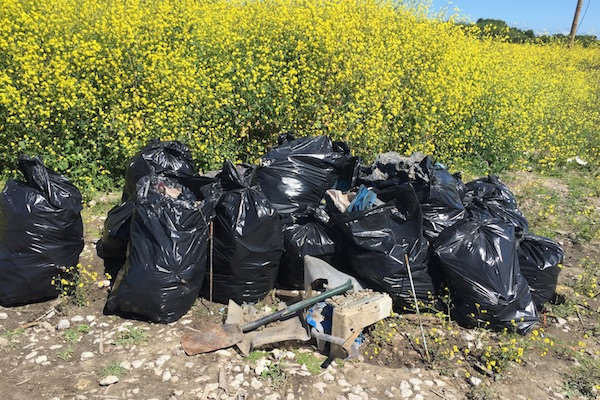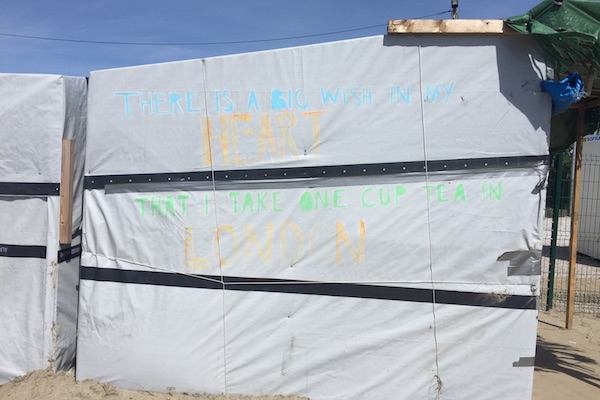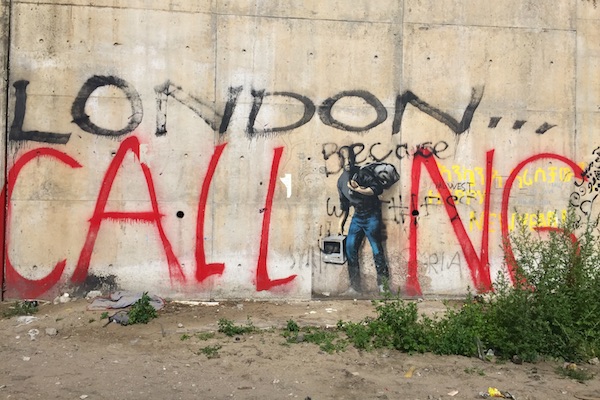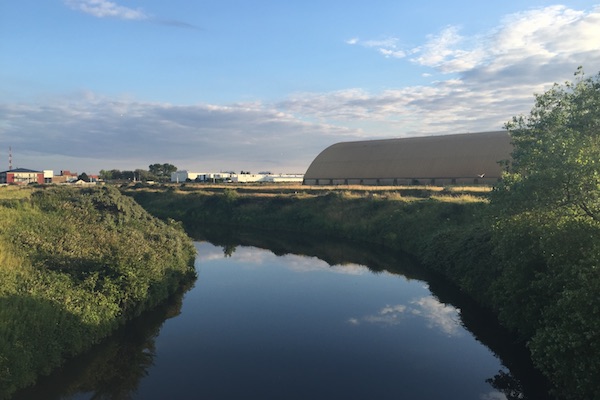After harassing the volunteer coordinator some persistence, I scored a spot on the Help Refugees distribution team. But first I got assigned to the Calais Jungle clean-up crew. The crew was in charge of cleaning the Calais Jungle and ensuring the camp’s water source wasn’t contaminated.
Johnny, an older guy who looked like a Sons of Anarchy cast member and seemed to be doing nothing all day, except sitting and watching others work, drove us there. The van only had four actual seats, so three people sat on the floor. Above the passenger windshield was a sign to inspire the volunteers: “You can’t help everyone but you can help someone.”
- My Observations of the Calais Jungle
- Calais Diaries: Day 1 at the Help Refugees Warehouse
- Lost in the Calais Jungle
- Saucepans, Jungle Books and a Conversation with a Weirdo
- That Time I Got Yelled at By One of the Refugees
- New Kabul Restaurant, The Kid, The Welcome Wagon, and A Momento
The Lake
When we couldn’t find the lake, which we had been instructed to clean up around, we settled on cleaning the area outside of Jungle Books and the Eritrean Church. We weren’t alone in our clean-up efforts: A group of Eritreans came out, wordlessly grabbed gloves and trash bags, and helped us pick up trash.
I had seen some of the Eritrean women walking around the camp, wearing headscarves, presuming them to be Muslim. It was interesting to find these women wore the same headscarves to their church service as hijabi Muslim women do.
The area we cleaned had been evacuated months before, but there was tarp and trash leftover from before. We spent close to an hour picking up garbage and ended up with over a dozen bags full of it.

While I was out there, a few Afghan guys approached me. I don’t know how they knew I was the Afghan volunteer. These young men were very concerned about whether they could continue their education in France. Unfortunately, I had no answers for them but promised to look into it.
Looking for the Women’s Center
I became frustrated that my language skills weren’t put to better use. I had met two girls who also wanted to help in a more meaningful way: A French-Israeli girl named Emma and an Italian girl named Isabelle. While picking up trash, I told Isabelle about the Calais Women and Children’s Center and she was very interested in going.
The easiest way to the Women and Children’s Center was to walk through the brush, onto the paved road, and into the container area. But being two girls on our own, we decided to walk through the center of the Calais Jungle instead. It was best to stay visible at all times.
Isabelle and I got lost, so I stopped by one of the Afghan restaurants to ask for directions. They were baffled that a Pashto-speaking volunteer was traipsing through the camp, but they responded in a friendly manner.
The restaurant itself was impressive: A very large space with tables and cots neatly arranged – it looked like an authentic Afghan restaurant. One of the cooks was tossing dough, undoubtedly for bolani.
With the recent evacuation of the Calais Jungle and subsequent fire, it makes me incredibly sad to think how much work went into building that restaurant and how easily it was destroyed.

Calais Women and Children’s Center
After walking into a tent neighborhood, we hit a dead end: A large metal fence separating the container camp. We walked around it, to where the bathrooms were. I spotted another Afghan and asked him if he knew where the Women and Children’s Center was. He pointed us next door to a double decker bus. We knocked on the door and after a very long wait Inca, a 24 year-old British volunteer, answered.
Inca and her mom, Liz Clegg, ran the Unofficial Women and Children’s Center of Calais. I would later meet Liz through a 12-year-old Afghan boy living in the camp with his 9-year-old brother. It was incredible how much time she devoted to the well-being of the most vulnerable residents in the Calais Jungle. During the recent evacuation, she was front and center, helping scared children figure out where to go next when the French authorities had failed to provide any instructions.
Inca explained that they were encouraging the refugees to stay in France, so teaching them French was a priority. Isabelle and Emma had expressed a desire to teach and while I didn’t speak French, I offered to translate. She gave us her email address and instructed us to contact her to arrange it.
We went back to our group and finished up our work. On our way back, I saw the first and only non-African woman in the Calais Jungle: A middle-aged Afghan woman standing alone next to a car filled with plastic bags. Isabelle and I were running late, so I very briefly chatted with her before heading back to our group.
Banksy’s Mural in the Calais Jungle
As we waited for Johnny to pick us up by the main camp entrance, I noticed something I’d been looking for: Banksy’s Steve Jobs mural!

I had assumed it was somewhere deep in the jungle, but here it was, right underneath the overpass. At that moment, I just happened to be glancing in that direction when I spotted it. It was a miracle that I did, because it was pretty far away and obscured by heavier graffiti surrounding it. I pointed it out to Kristin and soon the other volunteers took notice, snapping photos until the van arrived. There wasn’t enough space in the car for everyone, so Max and a few others were left behind.
When I caught up with Max later, he relayed what happened while the remaining volunteers waited for a ride. A 10-year-old boy approached the group. His older brother followed and began chatting with them in a friendly manner. That’s when Max spotted the younger boy stealing a wallet right out of an Italian volunteers’ pocket.
The pair walked away as Max told him what happened. The Italian went after them demanding his wallet back and, incredibly, they complied. It was pretty insane that this occurred less than 20 feet from the watchful gaze of a CRS officer.
Of course, the volunteers who witnessed the incident were undeterred in their compassion for the refugees. “These are desperate people in a desperate situation. We may do the same if we were in their shoes.” I found this outlook refreshing in today’s prevailing climate of pessimism.
A Real Life Oliver Twist
At Jungle Books, a middle-aged Sudanese man approached me, asking if he could read Oliver Twist and have me correct his grammar. When he started reading from the passage about a boy who wanted to go to London because he heard there were better living conditions there, the parallels between the story and this man’s reality were not lost on me:
“The stone…bore in large characters an intimation that it was just seventy miles from that spot to London…London! – that great place!…He had often heard the old men in the workhouse, too, say that no lad of spirit need want in London, and that there were ways of living in that vast city which those who had been bred up in the country parts had no idea of. It was the very place for a homeless boy, who must die in the streets unless some one helped him.”
His English was good, but I had to remind him not to pronounce the “e” in words ending in “ed.” When he got the hang of it, it was a satisfying victory for both of us. At one point he asked me what “poor” meant and I tried to explain it without hitting him in the face with a definition that described his exact circumstances.
It struck me how little that word actually gets used in America and how awkward it can be to define it when it isn’t commonly used like it is in countries that are, well…poor.
The American Living in the Calais Jungle
That day, I noticed a guy squatting on the floor by a picnic table. He was in his mid-20’s, disheveled, with scruffy facial hair. Recognizing his American accent, I asked where he was from and he said, “The Midwest.”
Where in the Midwest?
“I can’t say. The government is always listening and you can’t tell anyone where you’re from or they’ll know where you are.”
Then he laughed, punched one of the guys in the arm and said, “Right? Right!?” I chalked it up to an odd sense of humor.
He asked where I was from and whether I lived in Berkeley. When I said no, he responded, “It’s a cool place. I did 6 months in __.” I googled the place and learned it was a park frequented by homeless people.
He had purchased a bus ticket to London and was turned away at the border. Why? “I don’t know! I told them I was going to London to study art. When they asked where, I said I didn’t know. When they asked how much money I had, I said none. So they put me back on the bus.” I told him his sarcastic answers may have been to blame but he claimed he wasn’t being sarcastic. I began to suspect he was mentally ill.
As my group prepared to leave, Max invited him stay in his apartment. Apparently, the guy had been camping in the woods for three weeks. Max called the guy’s family in the U.S. and they arranged to fly him home. I marveled at this gesture of kindness. Few people would be this open to having a stranger live with them, let alone a mentally ill homeless man they had just met.
My Commute from the Calais Jungle to the City Center
There was no room in any of the cars, so me and two other volunteers walked back to town after wrapping things up at Jungle Books. When I first heard the Calais Jungle was 2.5 miles (or a 1 hour walk) from the city center, it sounded completely insane. However, for the next three days I would walk this route and actually enjoyed it. It also hit me that this commute was about the same length of time it used to take me to drive to work every morning.

Along the way, we passed a steady stream of refugees from the Calais Jungle, who were either new arrivals or returned from a trip into town to buy essentials. No one even gave us a second look, let alone threatened us in any way. In fact, the patrolling CRS vans probably put us more on edge than the never-ending line of migrants…
[jetpack_subscription_form title=”Subscribe via email for more points, miles and free travel”]